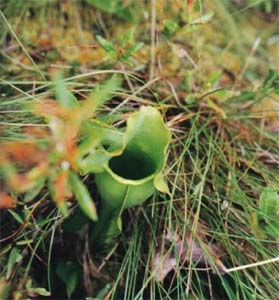






Wow, a meat eating plant! Awesome, and perhaps a little scary? Well, we agree that it's awesome. But, it certainly is not scary. Most carnivorous plants eat insects. Some carnivorous plants will capture and consume frogs and other small mammals. But, there are no known species of plants that are big enough, or capable, of eating humans.....Whew!!!
While we focus attention on plants that eat their prey, some capture them, but do not consume them. For example, the Catchfly flower, as it's name implies, catches flies and small insects. It's sticky calyces catches insects and doesn't let them go. But, the plant does not eat or absorb he insect.
The world of carnivorous plants is a fascinating one. Most of us know of the most popular ones, like Venus Flytrap, Pitcher plant, and Bladderworts. Actually, there are several hundred species of carnivorous plants, that can be found in their native environment, all over the world. They are found in warm and cold climates, too.
Carnivorous plants grow in areas with nutrient poor soil. Nature adapted them to these poor soil conditions with the ability to capture (mostly) insects to supplement the lack of nutrients in the soil. While gardeners and homeowners are attracted to these plants for their fascinating insect trapping characteristics, there is a wide range of attractive foliage and flowers.
Carnivorous plants can be grown indoors or out. They are very popular as house plant. Family members, young and old alike, will enjoy feeding the plants.
Did you Know? Charles Darwin was fascinated by these plants and performed many experiments on them.
Carnivorous Plants Trapping Methods:
Catchfly Flower - the plant's sticky calyses captures flies and insects. However, the plant doesn not eat them.
Pitfall - The most common of these are "Pitcher Plants" pictured at the top of this page. Nectar in and around the pitcher attracts the insects. They enter and fall in.
Steel Trap - An insect enters the trap and triggers the plant to slam the trap shut. Unless you are an insect lover, it's fun to watch. The best known plant in this category is the Venus Flytrap.
Suction Trap - The trap looks like a bulb or egg, called a bladder. The bladder has a hole with a trap door. Inside the bladder is a vacuum. The insect is sucked into the bladder. These plants are commonly called bladderworts.
Flypaper - Sticky hairs on the leaves capture insects. Plants are either active of passive. Passive leaves do not move. Active flypaper leaves curl up as they capture insects.
Lobster Pot - Hairs of the pot only allow one way movement, deeper and deeper into the trap.
Plant Propagation:
Most varieties are propagated by tubers, tuberous roots, or rhizomes. Others, are propagated from seed.
How to Grow Carnivorous Plants:
Carnivorous plants are easy to grow. They grow in acidic, poor soils that lack nutrients. They prefer moist to wet soil, depending upon the species. While temperature ranges vary among species, most plants prefer a humid environment.
Many people grow these plants indoors. The most popular is the Venus Fly Trap. Use soil poor in nutrients, spaghnum moss, or peat moss. Do not plant in any soils where fertilizer or other nutrients have been added. Any fertilizer can burn the roots.
Most species require full sunlight. If growing as a houseplant, place in the sunniest window. The use of grow-lights is helpful.
Most plants prefer moist to wet soils during the growing period. It is important to know which your plant prefers in order to provide optimum growing conditions. Make sure to inquire when you purchase plants.
Important: Fertilizer is not recommended and can be harmful to your plant. Carnivorous plants are used to extremely poor soil conditions. Any additional fertilizer can burn the roots.
Most carnivorous plants require a dormant period. Some plants will die back right to the roots, or appear dead.
Feeding Plants:
Now the fun begins. Growing in extremely poor soils, the roots do not find enough nutrients to survive. They must consume a regular supply of insects for survival. Grown outdoors, the plants will naturally attract and capture the insects it needs.
If you grow them indoors as houseplants, chances are (hopefully) you do not have a lot of insects in the house. You may need to supplement their diet. You can capture and use small insects. Or, you can use fresh, uncooked meat. Tiny pieces of hamburg often work well. In a family setting, there is usually no shortage of family members volunteering to feed the plants.
Copyright © www.100flowers.win Botanic Garden All Rights Reserved